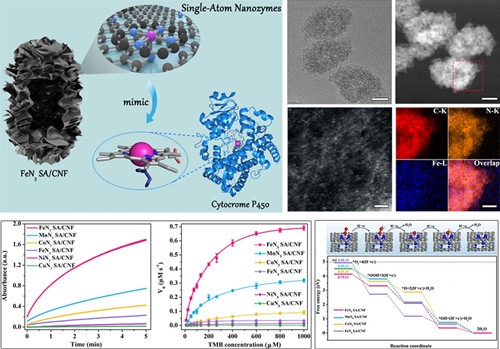May 8 2019
Nanozymes are catalytic nanomaterials with enzyme-like properties and with the benefits of high stability, low cost, ease of mass production, and tunable catalytic activity. They have been extensively applied in biosensing, therapeutics, and environmental protection.
 Schematic illustration of atomically dispersed Fe sites mimicking the active center of Cytochrome P450, atomic structure characterization, as well as the experimental and theoretical investigation of oxidase-like activity of single-atom nanozymes. (Image credit: DONG Shaojun)
Schematic illustration of atomically dispersed Fe sites mimicking the active center of Cytochrome P450, atomic structure characterization, as well as the experimental and theoretical investigation of oxidase-like activity of single-atom nanozymes. (Image credit: DONG Shaojun)
However, low densities of active sites always exhibit considerably lower catalytic activity when compared to natural enzymes, and the inhomogeneous elemental constitution and facet structure-derived complex catalytic mechanisms critically limit the widespread applications of traditional nanozymes.
A research group headed by Prof. DONG Shaojun from the Changchun Institute of Applied Chemistry (CIAC) of the Chinese Academy of Sciences revealed a new class of single-atom nanozymes as potential next-generation nanozymes, which combined the high-tech single-atom technology with inherent enzyme-like active sites.
They produced single-atom nanozymes of carbon nanoframe confined axial N-coordinated FeN5 centers (FeN5 SA/CNF). Experimental studies and theoretical calculations discovered that the highest oxidase-like activity of FeN5 SA/CNF was obtained from the enzyme-like active sites and catalytic mechanisms.
The atomically dispersed metal centers increased the density and atomic utilization efficiency of active sites. The distinct coordination structure offered an apparent experimental model for mechanism investigation.
The current results implied that the single-atom nanozymes overcame the serious limitations of traditional nanozymes, and imitating the active sites of natural enzymes is an efficient technique for the production of single-atom nanozymes with high activity and clear mechanism.
In addition, the catalytic property and the mechanism of single-atom nanozymes are mostly dependent on the steric configuration of active centers, instead of the size, structure, or facet of the supports. Therefore, by changing the supported nanomaterials, some kinds of active sites can be expanded to include general applications with specific enzyme-like mechanism.
The research, reported in Science Advances, demonstrated that the defined single-atom nanozymes offer a new prospect to the catalytic mechanism and rational design of nanozymes, and show great promise to become the next-generation nanozymes.